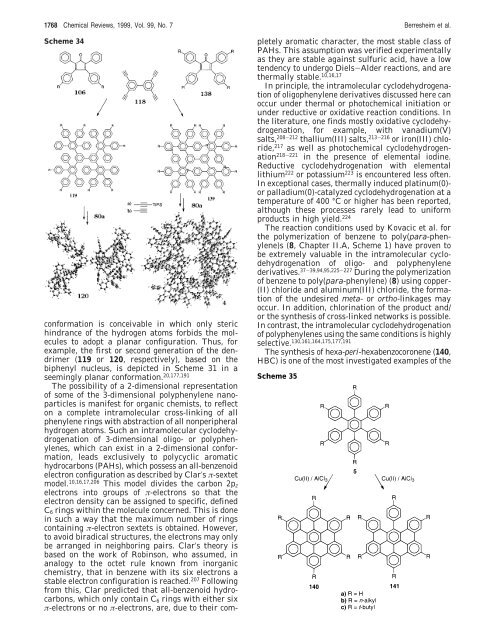Polyphenylene Nanostructures - Cluster for Molecular Chemistry
Polyphenylene Nanostructures - Cluster for Molecular Chemistry
Polyphenylene Nanostructures - Cluster for Molecular Chemistry
You also want an ePaper? Increase the reach of your titles
YUMPU automatically turns print PDFs into web optimized ePapers that Google loves.
1768 Chemical Reviews, 1999, Vol. 99, No. 7 Berresheim et al.<br />
Scheme 34<br />
con<strong>for</strong>mation is conceivable in which only steric<br />
hindrance of the hydrogen atoms <strong>for</strong>bids the molecules<br />
to adopt a planar configuration. Thus, <strong>for</strong><br />
example, the first or second generation of the dendrimer<br />
(119 or 120, respectively), based on the<br />
biphenyl nucleus, is depicted in Scheme 31 in a<br />
seemingly planar con<strong>for</strong>mation. 20,177,191<br />
The possibility of a 2-dimensional representation<br />
of some of the 3-dimensional polyphenylene nanoparticles<br />
is manifest <strong>for</strong> organic chemists, to reflect<br />
on a complete intramolecular cross-linking of all<br />
phenylene rings with abstraction of all nonperipheral<br />
hydrogen atoms. Such an intramolecular cyclodehydrogenation<br />
of 3-dimensional oligo- or polyphenylenes,<br />
which can exist in a 2-dimensional con<strong>for</strong>mation,<br />
leads exclusively to polycyclic aromatic<br />
hydrocarbons (PAHs), which possess an all-benzenoid<br />
electron configuration as described by Clar’s π-sextet<br />
model. 10,16,17,206 This model divides the carbon 2pz<br />
electrons into groups of π-electrons so that the<br />
electron density can be assigned to specific, defined<br />
C6 rings within the molecule concerned. This is done<br />
in such a way that the maximum number of rings<br />
containing π-electron sextets is obtained. However,<br />
to avoid biradical structures, the electrons may only<br />
be arranged in neighboring pairs. Clar’s theory is<br />
based on the work of Robinson, who assumed, in<br />
analogy to the octet rule known from inorganic<br />
chemistry, that in benzene with its six electrons a<br />
stable electron configuration is reached. 207 Following<br />
from this, Clar predicted that all-benzenoid hydrocarbons,<br />
which only contain C6 rings with either six<br />
π-electrons or no π-electrons, are, due to their com-<br />
pletely aromatic character, the most stable class of<br />
PAHs. This assumption was verified experimentally<br />
as they are stable against sulfuric acid, have a low<br />
tendency to undergo Diels-Alder reactions, and are<br />
thermally stable. 10,16,17<br />
In principle, the intramolecular cyclodehydrogenation<br />
of oligophenylene derivatives discussed here can<br />
occur under thermal or photochemical initiation or<br />
under reductive or oxidative reaction conditions. In<br />
the literature, one finds mostly oxidative cyclodehydrogenation,<br />
<strong>for</strong> example, with vanadium(V)<br />
salts, 208-212 thallium(III) salts, 213-216 or iron(III) chloride,<br />
217 as well as photochemical cyclodehydrogenation<br />
218-221 in the presence of elemental iodine.<br />
Reductive cyclodehydrogenation with elemental<br />
lithium 222 or potassium 223 is encountered less often.<br />
In exceptional cases, thermally induced platinum(0)or<br />
palladium(0)-catalyzed cyclodehydrogenation at a<br />
temperature of 400 °C or higher has been reported,<br />
although these processes rarely lead to uni<strong>for</strong>m<br />
products in high yield. 224<br />
The reaction conditions used by Kovacic et al. <strong>for</strong><br />
the polymerization of benzene to poly(para-phenylene)s<br />
(8, Chapter II.A, Scheme 1) have proven to<br />
be extremely valuable in the intramolecular cyclodehydrogenation<br />
of oligo- and polyphenylene<br />
derivatives. 37-39,94,95,225-227 During the polymerization<br />
of benzene to poly(para-phenylene) (8) using copper-<br />
(II) chloride and aluminum(III) chloride, the <strong>for</strong>mation<br />
of the undesired meta- orortho-linkages may<br />
occur. In addition, chlorination of the product and/<br />
or the synthesis of cross-linked networks is possible.<br />
In contrast, the intramolecular cyclodehydrogenation<br />
of polyphenylenes using the same conditions is highly<br />
selective. 130,161,164,175,177,191<br />
The synthesis of hexa-peri-hexabenzocoronene (140,<br />
HBC) is one of the most investigated examples of the<br />
Scheme 35

















